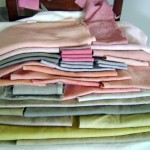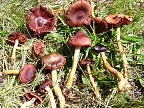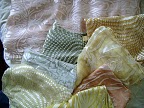I haven’t dyed anything for years. My dye kitchen paraphernalia is packed away along with whatever dyes I bought back in the early eighties. I did chemical dyeing then, but the irritation of setting up a kitchen and hot plates outside, worrying about extension cords and large pots of boiling water, and protecting the finished product from kids, pets and the weather took its toll on my patience. I decided that life was too short to bother with dyeing. That didn’t stop me from buying books on dyeing or going to workshops and lectures on dyeing. I just didn’t set up my dye kitchen and actually do any of it.
However, exchanging e-mails with Dorothy Beebee and, at her suggestion, Karen Tate and Gayle Still, I may unpack some dye pots.
Karen Tate wrote that, as far as processing the mushrooms, it is easy as making a cup of tea! Put in broken up pieces of dried, fresh or frozen mushrooms into a large pot of water, bring to a boil and simmer for an hour. Fresh, frozen and dried mushrooms of the same specimen will yield different shades of the color. Karen continued by saying she didn’t have much experiences with what those differences were because, like a true Californian, she tended to use fresh mushrooms. A mordant must be used in this process and the mordants of choice are alum and iron because they are less toxic choices.

mushroom dyed fabric to be used in a hooked rug - Karen Tate

western red dye mushrooms photo by Karen Tate

Silk scarves dyed with mushrooms-Gayle Stiles
After reading their emails and seeing their websites, I’ve concluded that mushroom dyeing is more alchemy than chemistry. The colors change with the condition of the mushroom and the area in which it grows. The color that comes from the mushroom doesn’t seem to have anything to do with the color of the fungus, so there is that element of surprise, too. The amount of fungus that goes into the dye bath is determined by trial and error. The process sounds quite serendipitous.
Before you run out and pick just any old mushroom to give it a try, you should probably do some reading.
Mushrooms for Color by Miriam Rice and Dorothy Beebee is currently out of print but you may find it in a library or a used edition.
Mushrooms for Dyes, Paper, Pigment And Mycostix by Miriam C. Rice.
The Rainbow beneath My Feet by Arleen R. and Alan E. Bessette written for the East Coast, but still handy.
All That Rain the Promises and Mushrooms Demystified by David Arora -must haves for mushroom identification.
Also go to fungals(dot)net and google both Miriam Rice and Dorothy Beebee where you will find abundant information about them and mushroom dyeing in this area and the world.
The next article will take you to the seashore